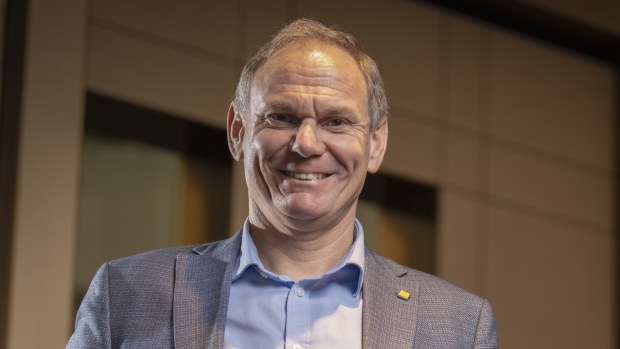CBA ready to launch its challenger to Stripe

Key Points
- Why it matters: CBA has developed a system similar to that of Stripe to manage payments.
- Powerboard is ready to be launched in September, nine months after it was announced.
- CBA will keep control of payments data, used to assess credit risk for lending.
Commonwealth Bank will launch a new payments service known as Powerboard next month, as it steps up its competitive response to US fintechs Stripe and Block, and protects its grip on retail transaction data from Silicon Valley disruptors.
CBA, which is used by one in four Australian businesses, expects low-margin payment services to drive corporate deposits and loans, where profits are larger.

“We have never sold more devices to merchants than we are at the moment,” says Mike Vacy-Lyle. Eamon Gallagher
Powerboard, which was first announced in December and is in its pilot stage this year, is an interface for businesses to manage payment collection from various providers, including from buy now pay later services, while allowing CBA to keep visibility of critical data used to assess credit risk.
Stripe, the large, private Irish-American fintech, has been aggressively expanding in the Australian market, making the big banks nervous that its payment services will obstruct their visibility of customer data.
Stripe’s software platform connects payment types and provides ancillary services such as data analytics and tax preparation. Last week, Stripe said it was being used by 500,000 businesses in Australia. It now allows merchants to use their iPhones to accept in-store payments (joining Westpac and Tyro in enabling Apple’s service). It has also released a new physical payment terminal.
It is now eight months since CBA first announced Powerboard as its payments project. Its group executive for business banking, Mike Vacy-Lyle, admitted that getting the product out to the market had been complex.
“It is a much tricker sell, as you do need specialist salespeople, so it is a longer sales conversation with the customer,” he said. “But we will be going out to the market in early September, and we will start distributing the product at scale. It will be a serious game changer for the mid-market.”
Call for regulation
Mr Vacy-Lyle said CBA “probably sweat payments more than any of our competitors – it is certainly the conversation that I am involved in the most at the moment”.
CBA chief executive Matt Comyn has been vocal in calling for emerging US payments platforms to be regulated by the Reserve Bank, an issue that is under consideration by the Treasury.
Although NAB remains the biggest business bank by loans, CBA has the largest “main financial institution” (MFI) market share, at 25.5 per cent, and the largest deposit book. Powerboard is core to its plan to catch up with NAB on lending and to win more business transaction accounts. This would provide the insights to let the bank deepen its relationships – and then lend.
CBA said in its full-year results last week that 90 per cent of its $35 billion in new lending to businesses over 2022-23 went to customers who already had a transaction account.
“We are all about the primacy of relationship,” Mr Vacy-Lyle said. “We want to make sure we keep the MFI, and we conduct the [payments] orchestration direct with customers, on the back of information we have.”
CBA is also being more aggressive in selling payment devices to merchants – an area that is also experiencing intense competition from the likes of Square (owned by Afterpay-acquirer Block) and Tyro Payments, which are both listed on the ASX.
Sales of CBA payment devices to merchants are up 30 per cent year-on-year, supporting its opening of 6000 new business accounts each week.
CBA sells more than 1000 merchant terminals a week and has more than 72,000 of its new smart terminals in the market.
“That is more than any other payments provider in Australia,” Mr Vacy-Lyle said. “We have never sold more devices to merchants than we are at the moment.”
Powerboard is also a defensive response to Afterpay and Zip, which obstruct the banks’ view of the nature of products being sold. That’s because the buy now, pay later provider typically appears as the “merchant of record” when transactions are made.
But when buy now, pay later providers – or PayPal – are connected to PowerBoard, CBA will get complete visibility of the transaction data, an increasingly valuable commodity in banking.
Introducing your Newsfeed
Follow the topics, people and companies that matter to you.
Find out moreRead More
Latest In Financial services
Fetching latest articles